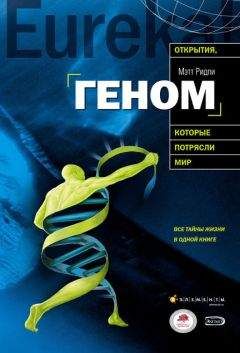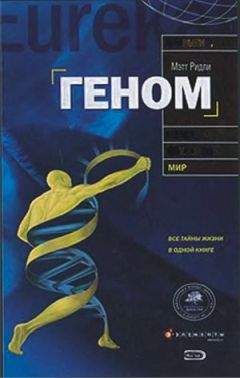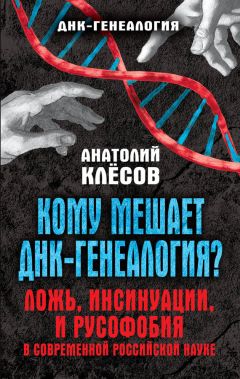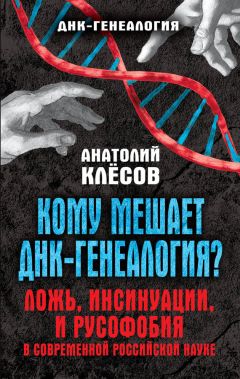Мэтт Ридли - Геном: автобиография вида в 23 главах

Помощь проекту
Геном: автобиография вида в 23 главах читать книгу онлайн
95
Reilly P. R., Page D. C. 1998. We’re off to see the genome. Nature Genetics 20: 15–17.
96
Ridrey M. 1993. The Red Queen: sex and the evolution of human nature. Viking, London.
97
Crow J. F. 1993. Felix Bernstein and the first human marker locus. Genetics 133: 4–7.
98
Yamomoto F. et al. 1990. Molecular genetic basis of the histo-blood group ABO system. Nature 345: 229–233.
99
Dean A. M. 1998. The molecular anatomy of the ancient adaptive event. American Scientist 86: 26–37.
100
Gilbert S. C. et al. 1998. Association of malaria parasite population structure, HLA and immunological antagonism. Science 279: 1173–1177.
101
Pier. G. B. et al. 1998. Salmonella typhi uses CFTR to enter intestinal epithelial cells. Nature 393: 79–82.
102
Hill A. V. S. 1996. Genetics of infectious disease resistance. Current Opinion in Genetics and Development 6: 348–353.
103
Ridley M. 1997. Diseases. Phoenix, London.
104
Cavalli-Sforza L. L., Cavalli-Sforza F. 1995. The great human diasporas. Addison Wesley, Reading, Massachusetts.
105
Wederkind C., Füri S. 1997. Body odour preferences in men and women: do they aim for specific MHC combinations or simply heterogeneity? Proceedings of the Royal Society of London, Series B 264: 1471–1479.
106
Hamilton W. D. 1990. Memes of Haldane and Jayakar in a theory of sex. Journal of Genetics 69: 17–32.
107
Martin P. 1997. The sickening mind: brain, immunity and disease. Harper Collins, London.
108
Becker J. B. et al. 1992. Behavioral endocrinology. MIT Press, Cambridge, Massachusetts.
109
Marmot et al. 1991. Health inequalities among British civil servants: the Whitehall II study. Lancet 337: 1387–1393.
110
Sapolsky R. M. 1997. The trouble with testosterone and other essays on the biology of the human predicament. Touchstone Press, New York.
111
Folstad I., Karter A. J. 1992. Parasites, bright males and the immunocompetence handicap. American Naturalist 139: 603–622.
112
Zuk M. 1992. The role of parasites in sexual selection: current evidence and future directions. Advances in the Study of Behaviour 21: 39–68.
113
Hamer D., Copeland P. 1998. Living with our genes. Doubleday, New York.
114
Efran J. S., Greene M. A., Gordon D. E. 1998. Lessons of the new genetics. Family Therapy Networker 22: 26–41.
115
Kagan J. 1994. Galen’s prophesy: temperament in human nature. Basic Books, New York.
116
Wurtman R. J., Wurtman J. J. 1994. Carbohydrates and depression. In: Masters R. D., McGuire M. T. (eds), The neurotransmitter revolution, p. 96–109. Southern Illinois University Press, Carbondale and Edwardsville.
117
Kaplan J. R. et al. 1996. Influence of dietary lipids on agonistic and affiliative behavior in Macaca fascicularis. American Journal of Primatology 38: 333–347.
118
Raleigh M. J., McGuire M. T. 1994. Serotonin, aggression and violence in vervet monkeys. In: Masters R. D., McGuire M. T. (eds), The neurotransmitter revolution, p. 129–145. Southern Illinois University Press, Carbondale and Edwardsville.
119
Bateson W. 1894. Materials for the study of variation. Macmillan, London.
120
Tautz D., Schmid K. J. 1998. From genes to individuals: developmental genes and the generation of the phenotype. Philosophical Transactions of the Royal Society of London, Series B 353: 231–240.
121
Nüsslein-Volhard J., Wieschaus E. 1980. Mutations affecting segment number and polarity in Drosophila. Nature 287: 795–801.
122
McGinnis et al. 1984. A homologous protein coding sequence in Drosophila homeotic genes and its conservation in other metazoans. Cell 37: 403–408;
Scott M., Weiner A. J. 1984. Structural relationships among genes that control development: sequence homology between the Antennapedia, Ultrabithorax, and fushi tarazu loci of Drosophila. Proceedings of the National Academy of Science of the USA 81: 4115–4119.
123
Arendt D., Nubler-Jung K. 1994. Inversion of the dorso-ventral axis? Nature 371: 26.
124
Sharman A. C., Brand M. 1998. Evolution and homology of the nervous system: cross-phylum rescues of otd/Otx genes. Trends in Genetics 14: 211–214.
125
Duboule D. 1995. Vertebrate hox genes and proliferation — an alternative pathway to homeosis. Current Opinion in Genetics and Development 5: 525–528;
Krumlauf R. 1995. Hox genes in vertebrate development. Cell 78: 191–201.
126
Zimmer C. 1998. At the water’s edge. Free Press, New York.
127
Cavalli-Sforza L. 1998. The DNA revolution in population genetics. Trends in Genetics 14: 60–65.
128
Jensen M. 1998. All about Adam. New Scientist, 11 July: 35–39.
129
Сведения приводились в Интернет-издании HMS Beagle: The Biomednet Magazine, www.biomednet.com/hmsbeagle, issue 20, November 1997.
130
Holden C., Mace R. 1997. Phylogenetic analysis of the evolution of lactose digestion in adults. Human Biology 69: 605–628.
131
Slagboom P. E., Droog S., Boomsma D. I. 1994. Genetic determination of telomere size in humans: a twin study of three age groups. American Journal of Human Genetics 55: 876–882.
132
Lingner J. et al. 1997. Reverse transcriptase motifs in the catalytic subunit of telomerase. Science 276: 561–567.
133
Clark M. S., Wall W. J. 1996. Chromosomes: the complex code. Chapman and Hall, London.
134
Harrington L. et al. 1997. A mammalian telomerase-associated protein. Science 275: 973–977;
Saito T. et al. 1997. Comparative gene-mapping of the human and mouse TEP1 genes, which encode one protein component of telomerases. Genomics 46: 46–50.
135
Bodnar A. G. et al. 1998. Extension of life-span by introduction of telomerase into normal human cells. Science 279: 349–352.
136
Niida H. et al. 1998. Severe growth defect in mouse cells lacking the telomerase RNA component. Nature Genetics 19: 203–206.
137
Chang E., Harley C. B. 1995. Telomere length and replicative aging in human vascular tissues. Proceedings of the National Academy of Science of the USA 92: 11190–11194.
138
Austad S. 1997. Why we age. John Wiley, New York.
139
Slagboom P. E., Droog S., Boomsma D. I. 1994. Genetic determination of telomere size in humans: a twin study of three age groups. American Journal of Human Genetics 55: 876–882.
140
Ivanova R. et al. 1998. HLA-DR alleles display sex-dependent effects on survival and discriminate between individual and familiar longevity. Human Molecular Genetics 7: 187–194.
141
Austad S. 1997. Why we age. John Wiley, New York.
142
Feng J. et al. 1995. The RNA component of human telomerase. Science 269: 1236–1241.
143
Holm V. et al. 1993. Prader-Willi syndrome: consensus diagnostic criteria. Pediatrics 91: 398–401.
144
Angelman H. 1965. ‘Puppet’ children. Developmental Medicine and Child Neurology 7: 681–688.
145
McGrath J., Solter D. 1984. Completion of mouse embryogenesis requires both the maternal and paternal genomes. Cell 37: 179–183;
Barton S. C., Surami M. A. H., Norris M. L. 1984. Role of paternal and maternal genomes in mouse development. Nature 311: 374–376.
146
Haig D., Westoby M. 1989. Parent-specific gene expression and the triploid endosperm. American Naturalist 134: 147–155.
147
Haig D., Graham C. 1991. Genomic imprinting and the strange case of the insulin-like growth factor II receptor. Cell 64: 1045–1046.
148
Dawson W. 1965. Fertility and size inheritance in a Peromyscus species cross. Evolution 19: 44–55;
Mestel R. 1998. The genetic battle of the sexes. Natural History 107: 44–49.
149
Hurst L. D., McVean G. T. 1997. Growth effects of uniparental disomies and the conflict theory of genomic imprinting. Trends in Genetics 13: 436–443;
Hurst L. D. 1997. Evolutionary theories of genomic imprinting. In: Reik W., Surani A. (eds), Genomic imprinting, p. 211–237. Oxford University Press, Oxford.
150
Horsthemke B. 1997. Imprinting in the Prader-Willi/Angelman syndrome region on human chromosome 15. In: Reik W., Surani A. (eds), Genomic imprinting, p. 177–190. Oxford University Press, Oxford.
151
Reik W., Constancia M. 1997. Making sense or antisense? Nature 389: 669–671.
152
McGrath J., Solter D. 1984. Completion of mouse embryogenesis requires both the maternal and paternal genomes. Cell 37: 179–183;
Barton S. C., Surami M. A. H., Norris M. L. 1984. Role of paternal and maternal genomes in mouse development. Nature 311: 374–376.
153
Jaenisch R. 1997. DNA methylation and imprinting: why bother? Trends in Genetics 13: 323–329.
154
Cassidy S. B. 1995. Uniparental disomy and genomic imprinting as cause of human genetic disease. Environmental and Molecular Mutagenesis 26: 13–20;
Kishino T., Wagstaff J. 1998. Genomic organisation of the UBE3A/E6-AP gene and related pseudogenes. Genomics 47: 101–107.
155
Jiang Y. et al. 1998. Imprinting in Angelman and Prader-Willi syndromes. Current Opinion in Genetics and developments 8: 334–342.
156
Allen N. D. 1995. Distribution of pathenogenetic cells in the mouse brain and their influence on brain development and behaviour. Proceedings of the National Academy of Sciences of the USA 92: 10782–10786;
Trivers R., Burt A. 1999. Kinship and genomic imprinting. Results and problems in cell differentiation 25: 1–21.
157
Vines G. 1997. Where did you get your brains? New Scientist, 3 May: 34–39;
Lefebvre L. et al. 1998. Abnormal maternal behaviour and growth retardation associated with loss of the imprinted gene Mest. Nature Genetics 20: 163–169.

























